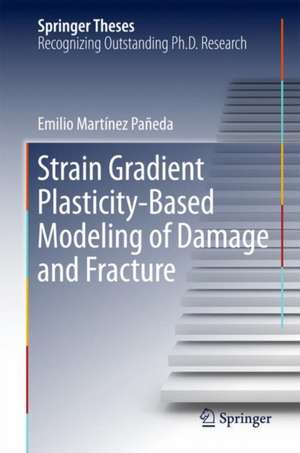Strain Gradient Plasticity-Based Modeling of Damage and Fracture: Springer Theses
Autor Emilio Martínez Pañedaen Limba Engleză Hardback – 5 sep 2017
| Toate formatele și edițiile | Preț | Express |
|---|---|---|
| Paperback (1) | 549.27 lei 38-44 zile | |
| Springer International Publishing – 11 aug 2018 | 549.27 lei 38-44 zile | |
| Hardback (1) | 640.88 lei 6-8 săpt. | |
| Springer International Publishing – 5 sep 2017 | 640.88 lei 6-8 săpt. |
Din seria Springer Theses
- 18%
 Preț: 997.88 lei
Preț: 997.88 lei -
 Preț: 389.88 lei
Preț: 389.88 lei - 15%
 Preț: 646.94 lei
Preț: 646.94 lei - 18%
 Preț: 943.43 lei
Preț: 943.43 lei -
 Preț: 399.29 lei
Preț: 399.29 lei - 18%
 Preț: 944.99 lei
Preț: 944.99 lei - 15%
 Preț: 636.80 lei
Preț: 636.80 lei - 18%
 Preț: 941.05 lei
Preț: 941.05 lei - 15%
 Preț: 643.16 lei
Preț: 643.16 lei - 15%
 Preț: 642.68 lei
Preț: 642.68 lei - 18%
 Preț: 1103.62 lei
Preț: 1103.62 lei - 20%
 Preț: 558.83 lei
Preț: 558.83 lei - 18%
 Preț: 1112.30 lei
Preț: 1112.30 lei - 18%
 Preț: 944.19 lei
Preț: 944.19 lei - 18%
 Preț: 1109.92 lei
Preț: 1109.92 lei - 18%
 Preț: 1217.27 lei
Preț: 1217.27 lei - 15%
 Preț: 640.06 lei
Preț: 640.06 lei - 15%
 Preț: 636.45 lei
Preț: 636.45 lei - 15%
 Preț: 640.06 lei
Preț: 640.06 lei - 15%
 Preț: 640.88 lei
Preț: 640.88 lei -
 Preț: 389.70 lei
Preț: 389.70 lei - 20%
 Preț: 563.91 lei
Preț: 563.91 lei -
 Preț: 393.35 lei
Preț: 393.35 lei - 15%
 Preț: 637.93 lei
Preț: 637.93 lei - 15%
 Preț: 641.85 lei
Preț: 641.85 lei - 18%
 Preț: 1225.94 lei
Preț: 1225.94 lei - 20%
 Preț: 551.36 lei
Preț: 551.36 lei - 18%
 Preț: 1229.10 lei
Preț: 1229.10 lei - 15%
 Preț: 639.25 lei
Preț: 639.25 lei - 18%
 Preț: 999.45 lei
Preț: 999.45 lei - 15%
 Preț: 640.06 lei
Preț: 640.06 lei - 18%
 Preț: 1220.45 lei
Preț: 1220.45 lei - 18%
 Preț: 1116.26 lei
Preț: 1116.26 lei - 18%
 Preț: 1110.72 lei
Preț: 1110.72 lei - 18%
 Preț: 1000.87 lei
Preț: 1000.87 lei - 18%
 Preț: 891.17 lei
Preț: 891.17 lei - 15%
 Preț: 640.06 lei
Preț: 640.06 lei - 5%
 Preț: 1154.07 lei
Preț: 1154.07 lei - 15%
 Preț: 635.96 lei
Preț: 635.96 lei - 15%
 Preț: 640.88 lei
Preț: 640.88 lei -
 Preț: 387.20 lei
Preț: 387.20 lei - 18%
 Preț: 1109.92 lei
Preț: 1109.92 lei -
 Preț: 385.25 lei
Preț: 385.25 lei -
 Preț: 385.25 lei
Preț: 385.25 lei - 18%
 Preț: 1112.30 lei
Preț: 1112.30 lei - 18%
 Preț: 999.45 lei
Preț: 999.45 lei -
 Preț: 386.99 lei
Preț: 386.99 lei - 15%
 Preț: 637.13 lei
Preț: 637.13 lei - 20%
 Preț: 554.21 lei
Preț: 554.21 lei - 20%
 Preț: 555.59 lei
Preț: 555.59 lei
Preț: 640.88 lei
Preț vechi: 753.97 lei
-15% Nou
Puncte Express: 961
Preț estimativ în valută:
122.63€ • 133.63$ • 103.34£
122.63€ • 133.63$ • 103.34£
Carte tipărită la comandă
Livrare economică 23 aprilie-07 mai
Preluare comenzi: 021 569.72.76
Specificații
ISBN-13: 9783319633831
ISBN-10: 331963383X
Pagini: 159
Ilustrații: XVII, 159 p. 66 illus., 47 illus. in color.
Dimensiuni: 155 x 235 mm
Greutate: 0.43 kg
Ediția:1st ed. 2018
Editura: Springer International Publishing
Colecția Springer
Seria Springer Theses
Locul publicării:Cham, Switzerland
ISBN-10: 331963383X
Pagini: 159
Ilustrații: XVII, 159 p. 66 illus., 47 illus. in color.
Dimensiuni: 155 x 235 mm
Greutate: 0.43 kg
Ediția:1st ed. 2018
Editura: Springer International Publishing
Colecția Springer
Seria Springer Theses
Locul publicării:Cham, Switzerland
Cuprins
Part.-Introduction.- Numerical framework.- Gradient plasticity formulations.- Numerical implementation.- Part ii.- Results.- Mechanism based crack tip characterization.- On fracture infinite strain gradient plasticity.- The role of energetic and dissipative length parameters.- Hydrogen diffusion towards the fracture process zone.- SGP-Based modelling of heac.- Conclusions.-Bibliography.
Textul de pe ultima copertă
This book provides a comprehensive introduction to numerical modeling of size effects in metal plasticity. The main classes of strain gradient plasticity formulations are described and efficiently implemented in the context of the finite element method. A robust numerical framework is presented and employed to investigate the role of strain gradients on structural integrity assessment. The results obtained reveal the need of incorporating the influence on geometrically necessary dislocations in the modeling of various damage mechanisms. Large gradients of plastic strain increase dislocation density, promoting strain hardening and elevating crack tip stresses. This stress elevation is quantified under both infinitesimal and finite deformation theories, rationalizing the experimental observation of cleavage fracture in the presence of significant plastic flow. Gradient-enhanced modeling of crack growth resistance, hydrogen diffusion and environmentally assisted cracking highlighted the relevance of an appropriate characterization of the mechanical response at the small scales involved in crack tip deformation. Particularly promising predictions are attained in the field of hydrogen embrittlement. The research has been conducted at the Universities of Cambridge, Oviedo, Luxembourg, and the Technical University of Denmark, in a collaborative effort to understand, model and optimize the mechanical response of engineering materials.
Caracteristici
Nominated as an outstanding PhD thesis by University of Oviedo, Spain Is the first book to address the modeling of size effects in metal plasticity Proposes a general framework for crack tip assessment accounting for the role of geometrically necessary dislocations (GNDs) in fracture and damage Includes supplementary material: sn.pub/extras
